8+ Sample Brand Design Proposal
-
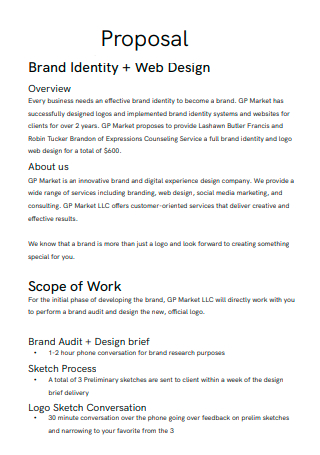
Brand Identity Web Design Proposal
download now -
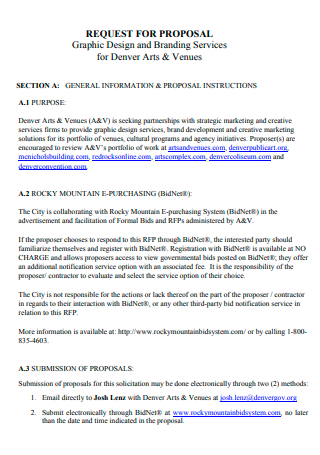
Branding Services Graphic Design Proposal
download now -
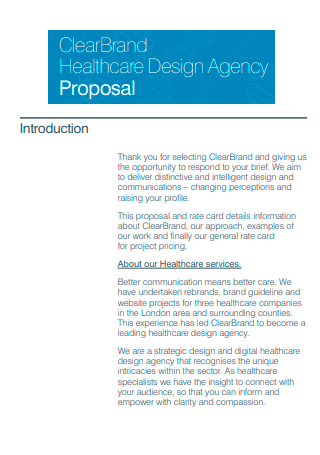
Brand Healthcare Design Agency Proposal
download now -
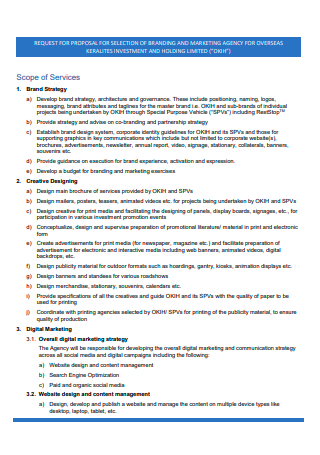
Brand Design Proposal in PDF
download now -
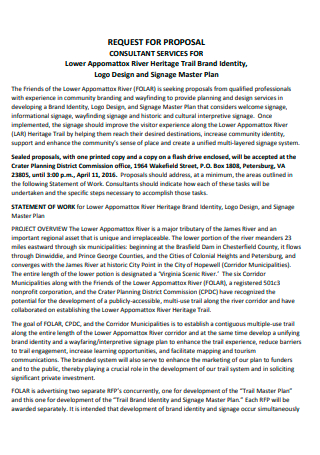
Brand Identity Logo Design Proposal
download now -
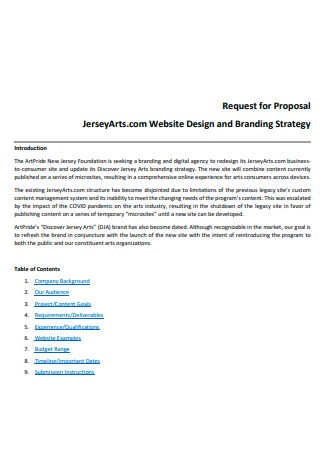
Branding Strategy Website Design Proposal
download now -
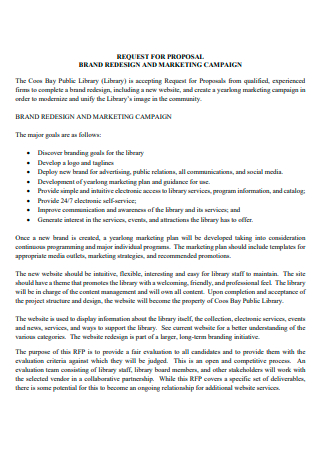
Brand ReDesign and Marketing Campaign Proposal
download now -
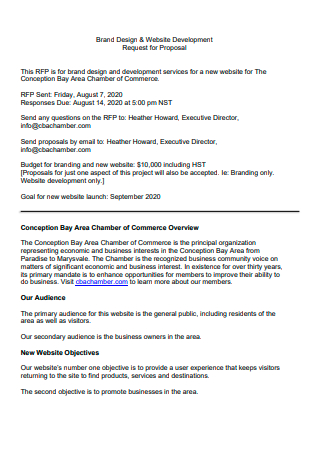
Brand Design and Website Development Proposal
download now -
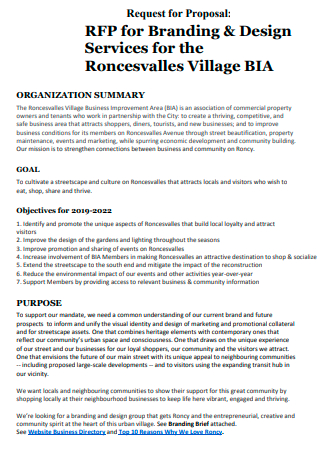
Branding and Design Service Proposal
download now
FREE Brand Design Proposal s to Download
8+ Sample Brand Design Proposal
What Is a Brand Design Proposal?
What Is Brand Design?
What Should a Brand Guide Include?
6 Ways Brand Will Add Value to the Business:
Five Key Brand Elements:
How to Write a Brand Design Proposal:
FAQs
What makes a brand successful?
What makes a brand unique?
Is brand an asset?
How can a brand increase profitability?
What Is a Brand Design Proposal?
A Brand Design Proposal is a document given by a marketing agency, branding specialist, or freelancer to a potential client. Its sole purpose is to persuade prospects to sign up for branding projects or services. This type of proposal helps make it easy to move with speed and confidence at closing time. Detailed proposal analytics give insights into how prospects are interacting with your proposals so you can time your follow-up to perfection.
Furthermore, a good branding proposal includes everything the prospect needs to make an informed decision, but not so much that they get bogged down in unimportant information.
Other brand project proposal includes an impressive cover, a persuasive overview, a scope of services, a timeframe, information about the team, and fees and sign-off section.
What Is Brand Design?
A brand design is essentially a promise a business makes to its consumers. The intention of branding in marketing is to establish trust within consumers and create loyalty. A brand not only gives buyers a way to remember a business, but it also creates an identity for the business and sets it apart from competitors.
Brand design reflects how a brand looks and how it feels—this means colors, typeface, graphic language, photography, and your logo. In the end, brand design is what brings the brand to life. It is what makes a brand easy to recognize to the people that matter to the business.
Since a brand is necessarily the personality and identity of a business, it is what forms the first impression of a business for potential customers and encompasses how it looks and sounds. It is how the market identifies an establishment compared to the competitors and will hopefully make it stand out. Components of a brand can include:
- Name
- Logo
- Tagline
- Colors
- Fonts and typography
- Tone of voice
- Features
- Symbols
- Experience
- Graphical element
- Niche
- Or anything that identifies individual businesses’ product or service as something unique
What Should a Brand Guide Include?
Brand guidelines are clearly defined rules and standards that coordinate how a brand should be represented to the world. Brand guidelines help businesses ensure consistency and show what the company is, what it does, and what it stands for. Think of it like a brand ‘rulebook’ that focuses on the overall look and feel of a brand identity.
- Information about the brand’s history, mission, values, and vision
- Guidelines on logo usage including color palette, file formats, minimum and maximum sizes, contexts, spacing, and usage permissions
- Fonts and text sizes—both print and digital
- Color palette including RGB and CMYK codes
- Business card and letterhead designs
- Tone of voice and grammar rules
- Design elements and types of imagery, icons, and photography to be used
Brand guidelines follow no strict formula, but the above elements are usually included and other elements can be added depending on the needs and wishes of a specific brand.
Lastly, brand guidelines should be shared and understood throughout the business. Even one wrongly used logo can damage a brand’s reputation for quality and professionalism. Collecting all the brand information in a brand book is a good idea. This could include more in-depth information such as advertising and editorial guidelines, website templates, and guidance on social media branding and tone of voice.
6 Ways Brand Will Add Value to the Business:
Businesses are quite often skeptical of the value of strategic branding. However, there are numbers of other examples of businesses who do not just sell a product or service, but sell experiences, communities, emotional connections, and relationships. Ultimately, they add value to people’s lives by using every aspect of their brand to support this.
1. Awareness
Building awareness is one of the greatest challenges for businesses. Yet it has the potential to have a huge impact on the bottom line. The greatest value of efficient brand and marketing practices is awareness. A business and an offer do not exist in the eyes of potential customers if they have never heard of you.
2. Price
An effective brand has the power to influence the market price of its goods or services because of the reputation it has given and retained in the minds of customers. Fundamentally, a business’ reputation and supporting brand is responsible for the premium consumers are willing to pay.
3. Engagement
The more you positively engage with your audience, the more likely you are to sell more often, to more people, at a higher price. Each business has a target audience with which it needs to engage. The best brands engage with their audiences so well they develop a following of brand advocates. These advocates become powerful sales tools for brands and it is for free! Word of mouth can be the most effective marketing channel.
4. Communication
Having a story to tell is one thing. Not telling it effectively or not connecting with the audience can mean your messages fall on deaf ears. At the heart of every communications strategy are core messages, that need to be communicated to the right audiences; what sets you apart from competitors, how you add value, the benefits of your product/service, the values which are instilled within the business—these will all expand the chances of engaging with consumers in a meaningful, relevant way.
5. Consistency
Consistency is key when it comes to building a great reputation. Developing your brand, getting everyone on the same page, and weaving these values into all aspects of your brand is essential. You need to be delivering in line with your promise to customers across every touchpoint they come into contact with; customer service, product quality, communications, staff members, and packaging all need to deliver a consistent message.
6. Personality
In the end, a successful business will sell more than it spends and most will aim to maximize profit, hit financial and customer targets and, ultimately, outgrow its competitors. Business can be a cold, transactional world. Brand and Marketing help to soften this laser focus, adding color to what is fundamentally a black and white practice. The best brands do this so well. Consumers are falling over themselves to buy what they are selling because they can engage with the brand in an emotional way. Essentially, powerful, meaningful, and engaging brands help businesses sell more products or services.
Five Key Brand Elements:
Successful branding begins with a well-defined brand that is relevant to the market. You need to carefully consider and define all five of the key brand elements you have to work on:
How to Write a Brand Design Proposal:
In this guide, be ready to take on new projects with greater confidence than ever, assured by the ability to prepare the right proposal to snag even the most challenging client.
-
Step 1: Talk to Your Prospective Client to Know About What They Want
Sitting down and talking to your lead is always the first step because you need to understand what is going on with your client. Going into any possible collaboration or project, you do not know what to expect. You have to find out what the client’s problem is and, therefore, what your design expertise and services can do for them to solve their problem.
Always ask relevant questions, and do not be afraid to ask as much as you think is necessary. After all, a prospect who realizes you ask a lot of questions is a prospect who realizes that you are doing everything in your power to understand their predicament, and that is quite impressive to prospects.
-
Step 2: Do a Lot of Research
At this stage, you will need to conduct a lot of research to understand your client’s brand, product, or service inside and out. Hopefully, the first meeting with your prospect went well enough that they wanted you to go ahead and draft a proposal. Now, the heavy lifting on your part really starts. Ask if the prospect has any proprietary documents or materials to help you understand their situation any better. You want to prepare yourself with as much info as possible to empower yourself to put together a proposal that addresses all of your prospect’s pain points in a meaningful way.
-
Step 3: Structure Your Proposal Sensibly by Starting with the Problem
The whole point of the brand design proposal is to solve your prospect’s problem, so it follows that your first section is meant to be about their main issue. Remember that your potential client does not really care about you or your brand: they care about their business problem and how you can come on board to solve it quickly and effortlessly for them. The purpose of your proposal, therefore, is to persuade them that you are exactly the designer for this ambitious job. Now, you are ready to write the actual proposal!
-
Step 4: Explain Your Solution
Your prospect has read this far because they know that you are the right designer for their project. This is where you have to make it count. Now, all that is left is to confirm their suspicion by presenting them with a solution to the aforementioned pain point. A good solution should contain all of the following particulars:
- A specific course of action to outline individual steps to achieve the solution.
- An explanation of how your strategy will help your prospect and solve their problem.
- Hard stats and data to support the course of action being proposed.
- Opportunities to review the strategy at consistent and specific intervals.
- A well-written solution is the heart of a brand design proposal—which is the section that has a huge impact on whether or not your prospect will take you up on your proposal or not. Take note that most clients spend the most time glancing at the proposals’ solution section.
-
Step 5: Clarify the Next Steps
If the prospect is reading up to this point, great! It is normally a really good sign that they are going to convert and sign on the dotted line. Before they do, however, they have got to get through the next steps. This last section is where you basically outline what the prospect has to do to finish a working relationship with you. This includes payment terms, general terms and conditions, and when your working relationship begins in earnest.
FAQs
What makes a brand successful?
A successful brand pays attention to their market, will come up with new ways to keep the interest of their target market, and are not afraid to innovate. Basically, it shows who your company is and why you are different to the competition. Have a distinctive personality that is suitable for your target audience. Demonstrate the value that your company provides for the customer, and how that value is created. Changing with the times or staying updated is important because a good brand does not stand still.
What makes a brand unique?
Part of maintaining and protecting a brand’s distinctiveness is the constant use of its core elements, which contain logos, colors, mascots, typography, taglines, and advertising style. The more prevalent and unique a brand is, the more recognition and loyalty it earns. Which means, recognition plus loyalty results in profit.
Is brand an asset?
Brand assets are elements, such as a color scheme, font, or jingle, that help identify a particular brand. These elements become brand assets only when customers associate them with a brand. If an element leads the audience to a different but similar brand, that element is not an asset.
How can a brand increase profitability?
There are four key areas that can help drive profitability. These are reducing costs; increasing productivity; increasing turnover; and increasing efficiency. Moreover, you can also expand into new market sectors, or develop new products or services.
Repetition is key to the success of the branding process. Once you have developed and defined a relevant brand, you must begin building the brand with employees, customers, prospects, partners, etc. through constant implementation.
Brand awareness becomes impossible to achieve, no matter how much money you spend on marketing without consistency. Moreover, to help ensure you build the habit of consistent brand execution company-wide, you must document your brand elements, styles, and techniques in order to give this guideline to every employee for their own use in their everyday activity.
